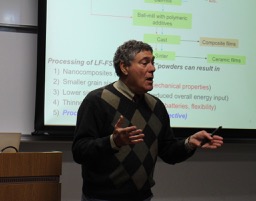The 41st JUACEP Seminar
Prof. Richard Laine of Univ. Michigan gave a talk at the 41st JUACEP Seminar with the title "Mixes-metal oxide nanopowder used to process dense single and multi-layer flexible thin (10-40µm) films including Li+ superionic electrolytes."
Summary:
Current fabrication methods used to produce thin ceramic films include traditional tape casting,spin casting of precursor solutions or vapor deposition methods. For the most part, tape casting relies on doctor blading slips made from ceramic powders with particle sizes > 0.5 µm. Consequently, sintering to full densities generally leads to final grain sizes of 2-5 µm. This in turn limits final film thicknesses typically to 40-50 µm simply to avoid films just a few grains thick, to limit susceptibility to brittle failure during further processing. In contrast spin-coating sol-gel and ceramic precursors can often provide uniform and sometimes epitaxial films (depending on substrate) but typically at thicknesses of just 1-5 µm and often only by repeated coating because of the very significant volume changes that occur as precursors transform to a dense ceramics. Vapor deposition is often used to process very high quality thin films, especially in the electronics industry but is equipment intensive and again thicknesses beyond about 5 µm are sometimes quite tedious to process. Thus, there is considerable need for rapid, facile and low cost routes to 5-40 µm thick dense (or porous) ceramic films that offer superior mechanical properties but also versatility in the types of ceramic materials that can be made. We present here, a simple method of making such films using wire-wound roller coating methods to cast thin polymer/ceramic nanopowder (NP) composites that can be made as single layers or laminated to make multiple ceramic laminates that on sintering provide dense single oxide thin films, ceramic composite thin films and ceramic/metal composite thin films. Several examples will be discussed including superionic lithium ion conducting electrolytes and cathode materials as well as some novel oxide materials.
 |
Graduate School and School of Engineering,Nagoya University
Furo-cho, Chikusa-ku, Nagoya,
464-8603, JAPAN
| TEL FAX |
+81-52-789-2799 |
|---|---|
| juacep-office@engg.nagoya-u.ac.jp |